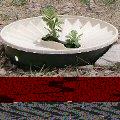This is the VOA Special English Agriculture Report.
Pieter Hoff used to export lilies and tulips from the Netherlands. He retired from the flower export business seven years ago. Now, he is trying to help people grow trees and plants in the desert -- and save water.
In many places, much of the freshwater supply is used for irrigation. Yet most of that water may be lost through evaporation into the air. So Pieter Hoff has invented a simple plastic device called the Groasis Waterboxx. He says he got the idea from nature.
PIETER HOFF: "If you look at nature, and I give an example in your own country, if you look to the Rocky Mountains of the Sierra Nevada, you find trees all over the mountains. So trees are actually able to grow on rocks. They have very strong roots." Mr. Hoff says the trick is that nature does not dig a hole like we humans do to plant seeds. Nature plants the seeds through birds or animals on top of the soil. Their waste then acts as a cover. It prevents the humidity in the soil from evaporating.
The Dutch inventor says he is simply copying that system. The Waterboxx is a round device about the size of a motorcycle tire. It sits flat on the ground with the bottom open to the earth. Seeds or a young planting grow out of a hole in the center.
Some people call the Waterboxx a water battery because of its ability to collect and store water.
The cover has deep ridges. These collect rainwater. But the device is designed to collect water even when there is no rain. The cover gets cold during the night and creates condensation.
The water is collected through two holes and in the holes there is a siphon to carry it to the soil. Pieter Hoff says the nice thing about the siphons is that, once collected, the water is not able to evaporate anymore.
The roots of the plant may have to grow several meters deep to reach groundwater. Once growth is established, the box can be removed and used to start another planting. The company also makes a version for one-time use.
Researchers at Mohammed the First University in Oujda, Morocco, tested the Waterboxx for three years in the Sahara. They said close to ninety percent of the trees planted with the device survived. Without it, they said, only about ten percent survived.
Pieter Hoff says he is now doing experiments with twenty thousand Waterboxxes in countries including Pakistan, Ecuador and the United States. The reusable box now sells for about fifteen dollars.
And that's the VOA Special English Agriculture Report, by Jerilyn Watson and Bob Burns. I'm Steve Ember.

